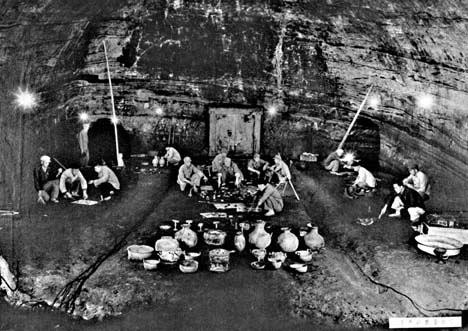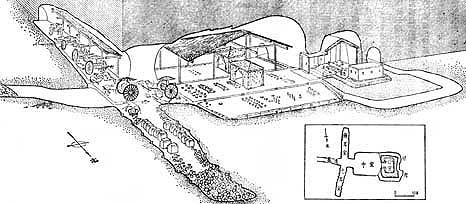|
ARCHAEOLOGISTS WORKING
ON LIU SHENG'S TOMB |
|

|
This photo was taken in 1968.
Is the sophistication of
this dig more or less than you would expect? |
| SOURCE: Zhonghuarenmingongheguo
chutu wenwu zhanlan (Beijing: Wenwu chubanshe, 1973), p. 68. |
|
|
| MORE: Modern
archaeology has a relatively short history in China; it was not
until the 20th century that systematic excavations of
archaeological sites were undertaken. The first
excavations, in the 1920s and 1930s, were led by foreign
archaeologists and yielded rich discoveries that encouraged
Chinese scientists to enter the new field themselves. In
addition, the People's Republic of China, with its ideological
commitment to a materialist view of history, has favored
archaeological research. |
|
The
Chinese imperial period began with the unification of China in 221 by
the state of Qin and the consolidation of a huge empire under the
succeeding Han dynasty (206 BC - AD 220). Consolidating the empire
involved not merely geographical expansion, but also bringing together
and reconciling the ideas and practices that had developed in the
different states. The new state
incorporated elements of Legalism, Daoism, and Confucianism in its
ideology but the officials who administered the state came to be
identified more and more with Confucian learning. Reflecting
the development of religious practices during the Warring States period,
Han art and literature are rich in references to spirits, portents,
myths, the strange, and the powerful.
In 1968 two tombs were found in
present-day Mancheng County in Hebei province (review map).
The first undisturbed royal Western Han tombs ever discovered, they
belong to the prince Liu Sheng (d. 113 BC), who was a son of Emperor
Jing Di, and Liu Sheng's consort Dou Wan. The structure and layout
of the tombs departs from earlier traditions in significant ways.
To see a drawing of Liu Sheng's tomb and learn about its layout, click
here. (In the Teachers' Guide, this is below.)
|
 |
|
Drawing of Liu Sheng's
tomb
|
SOURCE: Wang
Zhongshu, Handai kaoguxue gaishuo (Beijing: Zhonghua
shuju, 1984), p. 87.
|
|
|
Liu Sheng and Dou Wan were buried in
two separate caves hollowed out of a mountainside. Each tomb
has an entrance passage, two side-chambers for storage, a large central
area, and a rear chamber in which the coffin was placed. The
central chambers in both tombs originally had wooden structures with
tile roofs, which have since collapsed.
Liu Sheng's tomb:
 |
Entrance passage: 65 feet long.
|
 |
South side-chamber: Chariots and
remains of horses.
|
 |
North side-chamber: Vessels and
jars for wine, grain, fish, and meat; Cooking utensils and
tableware.
|
 |
Central chamber: 50 feet long by
40 feet wide. Large canopies, bronze vessels, lacquerware,
pottery, and clay figures of attendants.
|
 |
Rear chamber: Lined with stone
slabs. Coffin placed on north side; a room on the south side
of the chamber contained small stone figures of servants, wine
flasks, lamps, and an incense burner. |
What are some differences in terms
of tomb construction between this tomb and the earlier ones examined?
How do the contents of the tomb and
the division of burial goods reflect changing beliefs about the
afterlife?
What is the likely significance of
the stone and clay figures?
|
| SOME THOUGHTS: Liu
Sheng's tomb shows the shift from burial pits to horizontal
rock-cut chambers. The stone-lined rear chambers are part
of a trend toward greater use of stone in mortuary structures.
In the central chamber
everything is laid out for a sumptuous banquet involving the
tomb occupant as the host, seated in a tent-like canopy.
Row of tables were set up for the imaginary guests. |
|
|

